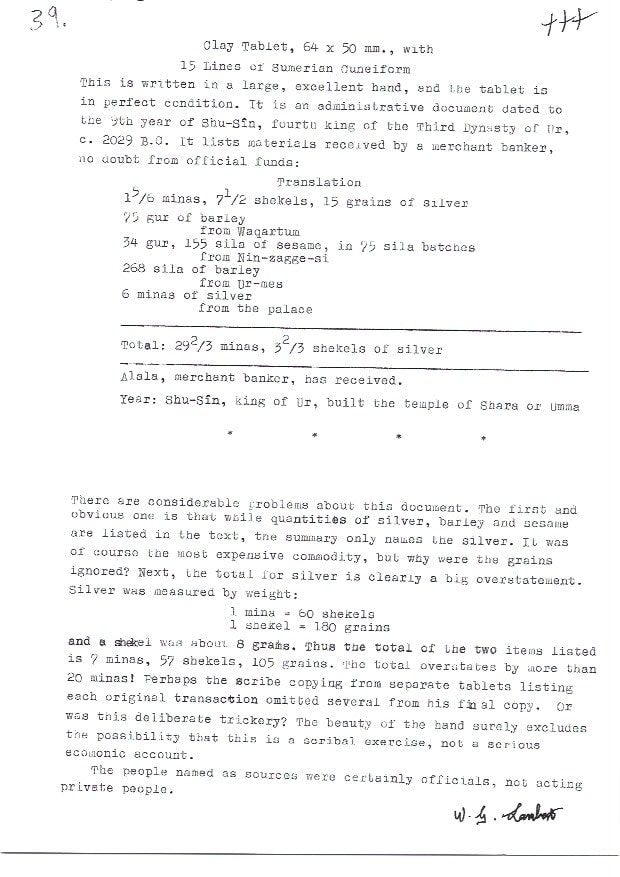Sumerian Cuneiform Tablet, 2029 BCE
2 x 2.5
LSO.208
Further images
Sumerian cuneiform is one of the earliest known forms of written expression. First appearing in the 4th millennium BC in what is now Iraq, it was dubbed cuneiform (‘wedge-shaped’) because...
Sumerian cuneiform is one of the earliest known forms of written expression. First appearing in the 4th millennium BC in what is now Iraq, it was dubbed cuneiform (‘wedge-shaped’) because of the distinctive wedge form of the letters, created by pressing a reed stylus into wet clay. Early Sumerian writings were essentially pictograms, which became simplified in the early and mid 3rd millennium BC to a series of strokes, along with a commensurate reduction in the number of discrete signs used (from c.1500 to 600). The script system had a very long life, and was used by the Sumerians as well as numerous later groups – notably the Assyrians, Elamites, Akkadians and Hittites – for around three thousand years. Certain signs and phonetic standards live on in modern languages of the Middle and Far East, but the writing system is essentially extinct. It was therefore cause for great excitement when the ‘code’ of ancient cuneiform was cracked by a group of English, French and German Assyriologists and philologists in the mid 19th century AD. This opened up a vital source of information about these ancient groups that could not have been obtained in any other way. Cuneiform was used on monuments dedicated to heroic – and usually royal – individuals, but perhaps it’s most important function was that of record keeping. The palace-based society at Ur and other large urban centres was accompanied by a remarkably complex and multifaceted bureaucracy, which was run by professional administrators and a priestly class, all of whom were answerable to central court control. Most of what we know about the way the culture was run and administered comes from cuneiform tablets, which record the everyday running of the temple and palace complexes in minute detail, as in the present case. The Barakat Gallery has secured the services of Professor Lambert (University of Birmingham), a renowned expert in decipherment and translation of cuneiform, to examine and process the information on these tablets. His analysis is presented below: Clay tablet 64 x 50 mm, with 15 lines of Sumerian Cuneiform. This is written in a large, excellent hand, and the tablet is in perfect condition. It is an administrative document dated to the 9th year of Shu-Sin, fourth king of the Third Dynasty of Ur, c. 2029 BC. It lists materials received by a merchant banker, no doubt from official funds. Translation:
1 5/6 minas, 7 ½ shekels, 15 grains of silver, 75 gur of barley from Waqurtu 34 gur, 155 sila of sesame, in 75 sila batches from Nin-zagge-s 268 sila of barley from Ur-Me 6 minas of silver from the palac Total: 29 2/3 minas, 3 2/3 shekels of silve Alala, merchant banker, has receive Year: Shu-Sin, king of Ur, built the temple of Shara or Umm There are considerable problems with this document. The first and obvious one is that while quantities of silver, barley and sesame are listed in the text, the summary only names the silver. It was of course the most expensive commodity, but why were the grains ignored? Next, the total for silver is clearly a big overstatement. Silver was measured by weight: 1 mina = 60 shekels, 1 shekel = 180 grains, and 1 shekel was about 8 grams. Thus, the total of the two items listed is 7 minas, 57 shekels, 105 grains. The total overstates by more than 20 minas! Perhaps the scribe copying from separate tablets listing each original transaction omitted several from his final copy. Or was this deliberate trickery? The beauty of the hand surely excludes the possibility that this was a scribal exercise, not a serious economic account. The people named as sources were certainly officials, not acting private people.
1 5/6 minas, 7 ½ shekels, 15 grains of silver, 75 gur of barley from Waqurtu 34 gur, 155 sila of sesame, in 75 sila batches from Nin-zagge-s 268 sila of barley from Ur-Me 6 minas of silver from the palac Total: 29 2/3 minas, 3 2/3 shekels of silve Alala, merchant banker, has receive Year: Shu-Sin, king of Ur, built the temple of Shara or Umm There are considerable problems with this document. The first and obvious one is that while quantities of silver, barley and sesame are listed in the text, the summary only names the silver. It was of course the most expensive commodity, but why were the grains ignored? Next, the total for silver is clearly a big overstatement. Silver was measured by weight: 1 mina = 60 shekels, 1 shekel = 180 grains, and 1 shekel was about 8 grams. Thus, the total of the two items listed is 7 minas, 57 shekels, 105 grains. The total overstates by more than 20 minas! Perhaps the scribe copying from separate tablets listing each original transaction omitted several from his final copy. Or was this deliberate trickery? The beauty of the hand surely excludes the possibility that this was a scribal exercise, not a serious economic account. The people named as sources were certainly officials, not acting private people.





